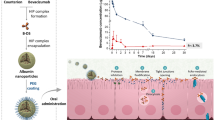Abstract
Purpose. Amikacin in small unilamellar liposomes (MiKasome®) has prolonged plasma residence (half-life > 24hr) and sustained efficacy in Gram-negative infection models. Since low-clearance liposomes may be subject to a lower rate of phagocytic uptake, we hypothesized this formulation may enhance amikacin distribution to tissues outside the mononuclear phagocyte system.
Methods. Rats received one intravenous dose (50 mg/kg) of conventional or liposomal amikacin. Amikacin was measured for ten days in plasma, twelve tissues, urine and bile.
Results. Liposomal amikacin increased and prolonged drug exposure in all tissues. Tissue half-lives (63−465 hr) exceeded the plasma half-life (24.5 hr). Peak levels occurred within 4 hours in some tissues, but were delayed 1−3 days in spleen, liver, lungs and duodenum, demonstrating the importance of characterizing the entire tissue concentration vs. time profile for liposomal drugs. Predicted steady-state tissue concentrations for twice weekly dosing were >100 μg/g. Less than half the liposomal amikacin was recovered in tissues and excreta, suggesting metabolism occurred. Amikacin was not detected in plasma ultrafiltrates. Tissue-plasma partition coefficients (0.2-0.8 in most tissues) estimated from tissue-plasma ratios at Tmax were similar to those estimated from tissue AUCs.
Conclusions. Low-clearance liposomal amikacin increased and prolonged drug residence in all tissues compared to conventional amikacin. The long tissue half-lives suggest liposomal amikacin is sequestered within tissues, and that an extended dosing interval is appropriate for chronic or prophylactic therapy with this formulation.
Similar content being viewed by others
REFERENCES
R. M. Fielding, G. Mukwaya, and R. A. Sandhaus. Clinical and preclinical studies with low-clearance liposomal Amikacin (MiKasome®). In M. C. Woodle and G. Storm (eds.), Long-Circulating Liposomes: Old Drugs, New Therapeutics, Springer-Verlag, New York, 1998, Ch. 15.
J. A. Karlowsky and G. G. Zhanel. Concepts on the use of liposomal antimicrobial agents: applications for aminoglycosides. Clin. Infect. Dis. 15:654–667 (1992).
E. T. Eng. Prophylactic and therapeutic treatment of Gram-negative septicemia with liposomal and non-liposomal encapsulated amikacin in immunocompromized mice. Thesis presented to California State Polytechnic University, Pomona, CA, 1996.
C. E. Swenson, K. A. Stewart, J. L. Hammett, et al. Pharmacokinetics and in vivo activity of liposome-encapsulated gentamicin. Antimicrob. Agents Chemother. 34: 235–240 (1990).
L. E. Bermudez, A. O. Yau-Young, J.-P. Lin, J. Cogger, and L. S. Young. Treatment of disseminated mycobacterium avium complex infection of beige mice with liposome-encapsulated aminoglycosides. J. Infect. Dis. 161:1262–1268 (1990).
W. O. Caster, J. Poncelet, A. B. Simon, and W. D. Armstrong. Tissue weights of the rat. Proc. Soc. Exp. Biol. Med. 91:122–126 (1956).
W. J. Jusko. Guidelines for collection and analysis of pharmacokinetic data. In W. E. Evans et al. (eds.), Applied Pharmacokinetics, 3rd edition. Applied Therapeutics, Inc., Vancouver, WA, 1992, Chapter 2.
D. P. McIntosh, R. J. Cooke, A. J. McLachlan, P. T. Dudley-Yates, and M. Rowland. Pharmacokinetics and tissue distribution of cisplatin and conjugates of cisplatin with carboxymethyldextran and A5B7 monoclonal antibody in CD1 mice. J. Pharm. Sci. 86:1478–1483 (1997).
R. M. Fielding, B. Feistner, L. Moon-McDermott, S. C. Gill, D. Roamer, and R. A. Bendele. Liposomal amikacin (Mikasome®): reduced clearance and volume of distribution in rats. Pharm. Res. 13:S-479 (1996).
B. Davies and T. Morris. Physiological parameters in laboratory animals and humans. Pharm. Res. 10:1095–1095 (1993).
F. C. Luft and S. A. Kleit. Renal parenchymal accumulation of aminoglycoside antibiotics in rats. J. Infect. Dis. 130:656–659 (1974).
I. A. J. M. Bakker-Woudenberg, M. T. ten Kate, L. E. T. Stearne-Cullen, and M. C. Woodle. Efficacy of gentamicin or ceftazidime entrapped in liposomes with prolonged blood circulation and enhanced localization in Klebsiella pneumoniae infected lung tissue. J. Infect Dis. 171:938–947 (1995).
F. Liu and D. Liu. Serum independent liposome uptake by mouse liver. Biochim. Biophys. Acta. 1278:5–11 (1996).
H. Harashima, Y. Ohnishi, and H. Kiwada. In vivo evaluation of the effect of the size and opsonization on the hepatic extraction of liposomes in rats: an application of the Oldendorf method. Biopharm. Drug Disp. 13:549–553 (1992).
S. D. Nightingale, S. L. Saletan, C. E. Swenson et al. Liposome-encapsulated gentamicin treatment of Mycobacterium avium—Mycobacterium intracellulare complex bacteremia in AIDS patients. Antimicrob. Agents Chemother. 37:1869–1872 (1993).
K. J. Huang, K.-F. Luk, and P. L. Beaumier. Volume of distribution and transcapillary passage of small unilamellar vesicles. Life Sci. 31:949–955 (1982).
A. H. Stirk and J. D. Baldeschwieler. Mechanism of endocytosis of surface-modified liposomes by mouse peritoneal macrophages. In K. Yagi (ed.), Medical Application of Liposomes, Japan Scientific Societies Press, Tokyo, 1990, pp. 31–41.
E. A. Forssen, R. Male-Brune, J. P. Adler-Moore, M. J. A. Lee, P. G. Schmidt, T. B. Krasieva, S. Shimizu, and B. J. Tromberg. Fluorescence imaging studies for the disposition of daunorubicin liposomes (DaunoXome) within tumor tissue. Cancer Res. 56:2066–2075 (1996).
R. M. Fielding, A. W. Singer, L. H. Wang, S. Babbar, and L. S. S. Guo. Relationship of pharmacokinetics and tissue distribution to reduced toxicity of colloidal amphotericin B in dogs. Antimicrob. Agents Chemother. 36(2):299–307 (1992).
M. Y. Huang and J. Schacht. Formation of a cytotoxic metabolite from gentamicin by liver. Biochem. Pharmacol. 40:R11–R14 (1990).
Author information
Authors and Affiliations
Rights and permissions
About this article
Cite this article
Fielding, R.M., Lewis, R.O. & Moon-McDermott, L. Altered Tissue Distribution and Elimination of Amikacin Encapsulated in Unilamellar, Low-Clearance Liposomes (MiKasome®). Pharm Res 15, 1775–1781 (1998). https://doi.org/10.1023/A:1011925132473
Issue Date:
DOI: https://doi.org/10.1023/A:1011925132473




